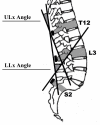Regional differences in lumbar spinal posture and the influence of low back pain
- PMID: 19014712
- PMCID: PMC2605454
- DOI: 10.1186/1471-2474-9-152
Regional differences in lumbar spinal posture and the influence of low back pain
Abstract
Background: Spinal posture is commonly a focus in the assessment and clinical management of low back pain (LBP) patients. However, the link between spinal posture and LBP is not fully understood. Recent evidence suggests that considering regional, rather than total lumbar spine posture is important. The purpose of this study was to determine; if there are regional differences in habitual lumbar spine posture and movement, and if these findings are influenced by LBP.
Methods: One hundred and seventy female undergraduate nursing students, with and without LBP, participated in this cross-sectional study. Lower lumbar (LLx), Upper lumbar (ULx) and total lumbar (TLx) spine angles were measured using an electromagnetic tracking system in static postures and across a range of functional tasks.
Results: Regional differences in lumbar posture and movement were found. Mean LLx posture did not correlate with ULx posture in sitting (r = 0.036, p = 0.638), but showed a moderate inverse correlation with ULx posture in usual standing (r = -0.505, p < 0.001). Regional differences in range of motion from reference postures in sitting and standing were evident. BMI accounted for regional differences found in all sitting and some standing measures. LBP was not associated with differences in regional lumbar spine angles or range of motion, with the exception of maximal backward bending range of motion (F = 5.18, p = 0.007).
Conclusion: This study supports the concept of regional differences within the lumbar spine during common postures and movements. Global lumbar spine kinematics do not reflect regional lumbar spine kinematics, which has implications for interpretation of measures of spinal posture, motion and loading. BMI influenced regional lumbar posture and movement, possibly representing adaptation due to load.
Figures
Similar articles
-
Lumbar Spine Alignment in Six Common Postures: An ROM Analysis With Implications for Deformity Correction.Spine (Phila Pa 1976). 2017 Oct 1;42(19):1447-1455. doi: 10.1097/BRS.0000000000002131. Spine (Phila Pa 1976). 2017. PMID: 28240654
-
Lumbar spine side bending is reduced in end range extension compared to neutral and end range flexion postures.Man Ther. 2014 Apr;19(2):114-8. doi: 10.1016/j.math.2013.08.004. Epub 2013 Sep 4. Man Ther. 2014. PMID: 24315299
-
Multi-segment spine kinematics: Relationship with dance training and low back pain.Gait Posture. 2019 Feb;68:274-279. doi: 10.1016/j.gaitpost.2018.12.001. Epub 2018 Dec 4. Gait Posture. 2019. PMID: 30551053
-
Kinematic Characteristics of Sit-to-Stand Movements in Patients With Low Back Pain: A Systematic Review.J Manipulative Physiol Ther. 2019 Sep;42(7):532-540. doi: 10.1016/j.jmpt.2018.12.004. J Manipulative Physiol Ther. 2019. PMID: 31864436
-
Differences in lumbar spine intradiscal pressure between standing and sitting postures: a comprehensive literature review.PeerJ. 2023 Oct 19;11:e16176. doi: 10.7717/peerj.16176. eCollection 2023. PeerJ. 2023. PMID: 37872945 Free PMC article. Review.
Cited by
-
Can 5-weeks of Hypopressive Exercise Influence Sagittal Lumbo-Pelvic Position in Athletic and Non-Athletic Females?Int J Exerc Sci. 2023 May 1;16(4):550-562. doi: 10.70252/KHQG8688. eCollection 2023. Int J Exerc Sci. 2023. PMID: 38288077 Free PMC article.
-
Lumbar spine posture and spinopelvic parameters change in various standing and sitting postures.Eur Spine J. 2019 May;28(5):1072-1081. doi: 10.1007/s00586-018-5846-z. Epub 2018 Nov 29. Eur Spine J. 2019. PMID: 30498961
-
Lumbar interspinous pressure pain threshold values for healthy young men and women and the effect of prolonged fully flexed lumbar sitting posture: An observational study.World J Orthop. 2020 Mar 18;11(3):158-166. doi: 10.5312/wjo.v11.i3.158. eCollection 2020 Mar 18. World J Orthop. 2020. PMID: 32280605 Free PMC article.
-
Patients With Chronic Low Back Pain Have an Individual Movement Signature: A Comparison of Angular Amplitude, Angular Velocity and Muscle Activity Across Multiple Functional Tasks.Front Bioeng Biotechnol. 2021 Nov 15;9:767974. doi: 10.3389/fbioe.2021.767974. eCollection 2021. Front Bioeng Biotechnol. 2021. PMID: 34869281 Free PMC article.
-
The Kinematics and Spondylosis of the Lumbar Spine Vary Depending on the Levels of Motion Segments in Individuals With Low Back Pain.Spine (Phila Pa 1976). 2017 Jul 1;42(13):E767-E774. doi: 10.1097/BRS.0000000000001967. Spine (Phila Pa 1976). 2017. PMID: 27831966 Free PMC article.
References
-
- Stansbury C, Lim T. Worker's Compensation in Western Australia Statistical Report 99/00 – 02/03. Perth, Australia; 2004.
-
- Waddell G. The Back Pain Revolution. 2. Edinburgh: Churchill Livingston; 2004. The Problem; pp. 1–7.
-
- Scannell J, McGill S. Lumbar posture – should it, and can it, be modified? A study of passive tissue stiffness and lumbar position during activities of daily living. Physical Therapy. 2003;83:907–917. - PubMed
Publication types
MeSH terms
LinkOut - more resources
Full Text Sources
Medical
Miscellaneous



